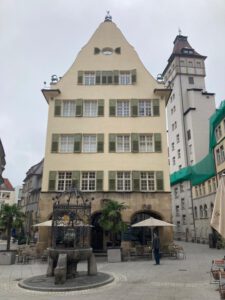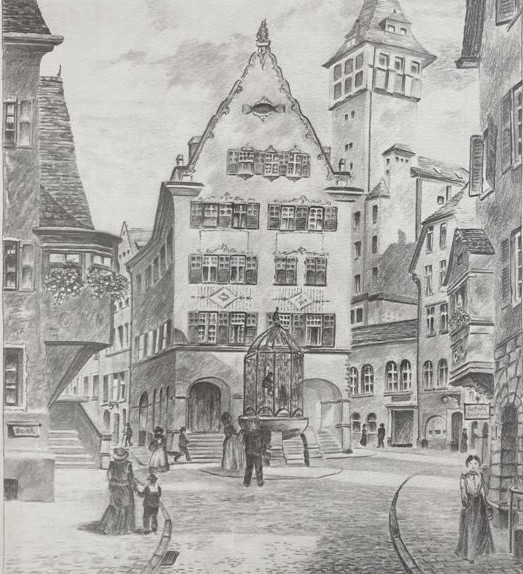Blog
Transforming Difficult Memories into Inclusive Futures: The Case of Stuttgart
By Dr Banu Pekol and Dr Annegret Warth
Cities, being hubs of a great variety of people, are also spaces in which the stories of these people and communities unfold. The places within cities, namely historic buildings, can be the only existing witness to social experiences of the past. Multi-track city diplomacy today includes multiple actors, from individuals to NGOs to Municipalities working on local issues with global relevance. GDL members Dr Banu Pekol and Dr Annegret Warth collaborated on a project and exhibition in Stuttgart, Germany bringing together these actors, to show how historic buildings tell us about how a city dealt with their dwellers of different backgrounds. Annegret managed the project and stakeholders, while Banu provided the concept and curated the exhibition.
People relate to the city in very different ways depending on their age and experience. In addition to these factors, there are the relationships between institutions and city dwellers, which also influences how the public views the different social groups residing there. Stuttgart, a city today known for its successful governance, work power and quality of life, also bears contradictory historical events.
What was the starting point of this project?
Annegret: Banu and I met at the European Parliament in 2018, when we were selected to present pitches that could be implemented in the upcoming budget covering the period 2021-2027. (City Diplomacy for Better EU Enlargement) I focused on the potentials of European mobility programmes for local governance in the youth field, and Banu on how through investing in heritage, it is possible to advocate the positive and cohesive power of our shared cultural values and to promote responsible citizenship towards our past and future. Both being GDL members, I hosted a GDL session on City Diplomacy (City Diplomacy and the Future of Diplomacy) and Banu hosted a Lab on Memory (Transnational Approach to Memory Culture » Global Diplomacy Lab). We kept in touch, collaborated on these initiatives and developed our friendship. Luck was on our side, and a few years ago we moved to the same region in southern Germany for our new jobs, which motivated us to collaborate on a project.
What was the concept of the project?
Banu: Connecting cultural heritage and inclusive diplomacy was at the core. My background lies in working with architectural heritage with dark pasts for peacebuilding. We shape our buildings, and then the buildings shape us. We form memories and associations with spaces, which can be triggered later in another foreign but familiar space. Buildings which carry traces of the past are strongest bridges in providing such inspiration, and channeling heritage and memory of even the furthest cultures.
Our first step was storytelling workshops held in two historic spaces with groups of young people of different social backgrounds living in Stuttgart. These spaces were Geißstraße 7 and Altes Waisenhaus; both which have a multiple layered history, involving comfortable as well as uncomfortable pasts.
The youth were guided to tell the story of what this building reminds them of, in relation to their cultural background. Afterwards, they were presented with the factual history of the building, and invited to discuss how it relates to their earlier interpretation.
What was typical of the GDL in your methodology?
Annegret: It was similar to the way GDL Labs are developed. In GDL Labs, we experiment, working to bring various stakeholders and experts together to understand the mechanisms of a certain challenge, and to brainstorm on solutions. In this project, we had a challenge, context and concept, and multiple varied stakeholders – some which were familiar to the subject, others which would provide key knowledge or skills. These were the Welthaus Stuttgart, Stiftung Geißstraße 7 and Lernort Geschichte. I had designed the session at the 2020 Bled Strategic Forum on City Diplomacy and the Future of Multilateralism (Bled Strategic Forum, August 31, 2020 » Global Diplomacy Lab) where we explored how pragmatism and problem-solving, rather than geopolitical interests, are driving global multilateral cooperation. I combined these learnings with knowledge from my role in the Stuttgart Municipality, where I work to mainstream education for sustainable development by encouraging intersectoral cooperation between education, civil society and administration. The project was even then funded by the Action Fund of the Partnership for Democracy Stuttgart and by the federal program “Democracy live!” of the Federal Ministry for Family Affairs, Senior Citizens, Women and Youth.
How was the exhibition curated to reflect inclusive futures in this setting?
Banu: The exhibition used the power of a strong historical character and multi-sensory features, embodied the historic space of the two buildings Geißstraße 7 and Altes Waisenhaus. It gave voice to and brought together the multiple, multicultural stories which were all distilled and manifested within the same space.
I curated the content of the exhibition from stories that youth with different cultural backgrounds told, based on what the buildings made them remember or relate to. These stories were combined with the actual history of the buildings, including its abandonment. The spaces acted as a bridge, bringing multiple geographies, cultures and heritages into a single room. These multiple narratives, which all have the historic spaces in common (whether symbolically or factually) were curated to be symbolically represented within the space. They gave birth to one meta-story, promoting the value of peaceful multicultural coexistence. Overall, the exhibition demonstrated that multiple, even seemingly incompatible narratives inspired by a historic space can come together to produce an experience more inclusive and transformational than a single narrative.

How do you see the future of this project?
Banu: We connected the history and the present of migration in Stuttgart through buildings and architecture, creating opportunities for young people from diverse backgrounds to intuitively and biographically connect to the topic. Furthermore, we created a space of visibility and empowerment for the voices of the participants. However, the concept is a pilot, and I would love to replicate it in other cities with buildings of difficult pasts, involving citizens from all backgrounds. Hopefully we will be able to do so in the future.
Annegret: In terms of Stuttgart, new local networks were created and organisations involved in the project can integrate the approaches they have learned through this project into their work. We also highlighted how today, both buildings refer to positive and negative aspects of integration, thus representing how local engagement initiated by trauma can bring change and new and positive approaches.
Migration and Integration in Stuttgart: The case of Stiftung Geißstraße and Altes Waisenhaus
- Stuttgart is the center of an economically strong region with world leading companies- received lots of migration – work as an integration factor, a city with one of the largest migration share in Germany.
- Both of the historical buildings that we explored during the the workshops and exhibition refer to the way the city has dealt with migration:
- In Geißstraße 7, following a fire attack in the 1990, many migrants died. This resulted in a local foundation which aims to support integration.
- The Altes Waisenhaus (Old Orphanage) has a long history of housing outsiders of society, and keeping them segregated from the rest of the city since the 20th century. Today it hosts different institutions that deal with migration and integration (Institut für Auslandsbeziehungen (ifa), municipal welcome center for migrants, World Café, Welthaus Stuttgart (Global Learning).
About the authors:
Dr Banu Pekol’s work focuses on peacebuilding and conflict transformation in relation to contested cultural heritage. Her work spans cultural heritage research on difficult pasts and projects that develop creative and research-based results, specialising in cultural diplomacy, contested heritage interpretation and management. Currently responsible for the work of the BMW Foundation in West Asia and North Africa, she previously worked on intercultural and interreligious conflict transformation and peace education at the Berghof Foundation.
Dr Annegret Warth has a strong background in academia, civil society and administration. She works at the interface between education and diplomacy by merging local, national and international perspectives on formal and non-formal education. At Stuttgart Municipality, she currently coordinates a network which aims to mainstream education for sustainable development by encouraging intersectoral cooperation between education, civil society and administration.
